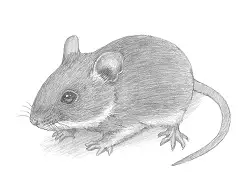
Step 7: Use the first circle as a guide to draw the rest of the hamster's head. Darken the basic path of the circle using short strokes to create the furry texture of the head. Make the bottom of the head wider than the initial circle to create the big cheeks. Add a few more strokes inside the head to emphasize the fur.

Step 8: Use the curved line that's under the head and on the left side as a guide to draw the hamster's first front leg. Draw four small, thin shapes along the right side of the guide for the toes. Make the toes pointy at the tips for the nails. Add a short, curved line to the left for the rest of the foot. Darken the basic path of the guide using short strokes to create the rest of the leg. Make the leg slightly bigger than the initial guide.

Step 9: Use the curved line on the right as a guide to draw the hamster's other front leg the same way. draw the toes as small, thin shapes with pointy tips along the edge of the guide. Draw the rest of he foot using a short, curved line. Use short strokes along the path of the guide to create the rest of the furry leg.

Step 10: Draw the shapes of the hamster's hind feet around the guide lines under the body. The toes on the on the foot on the left are made up of small, circular shapes because the toes are pointing toward the viewer. The toes of the foot on the right should be longer because they are pointing to the right. Use the big circle as a guide to draw the rest of the body. Darken the basic path of the circle using short strokes to create the furry shape of the body.

Step 11: For a cleaner look, erase as much as you can of the initial guide lines. Don't worry about erasing all of the guides. It's okay to leave some behind. Re-draw any final sketch lines you may have accidentally erased.

Final Step: Shade your drawing for extra detail. Hamsters can have a variety of coat patterns, so you can shade yours however you'd like. For this pattern, use a medium value all over the body except for the area under the head and on the underside of the body. Shade lightly at first and gradually build up to darker values. For light values, push down very lightly on your pencil and push down harder for darker values. As you shade the body, use strokes that go in the general direction of the fur. Separate each stroke a bit as you shade so that the white of the paper comes through and creates a more furry texture. Use a slightly darker value throughout the body for shadows. Add a cast shadow at the bottom using a medium value. Shading can be time-consuming, so be patient and take breaks. It's a good idea to use reference as you shade for a more accurate depiction of a hamster. If you have a pet hamster, try to duplicate its coat pattern on your drawing. For a more detailed guide on how to shade, check out this tutorial: How to shade.
Thanks for visiting! Subscribe to the How2DrawAnimals YouTube Channel for a new tutorial every week.
To learn how to draw popular cartoon characters, visit EasyDrawingTutorials.com.
To learn how to draw Manga, visit How2DrawManga.com.
RELATED TUTORIALS
 |
 |
 |







